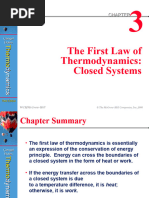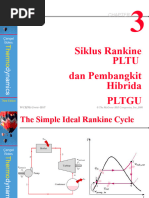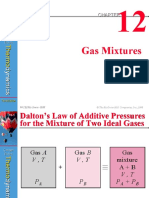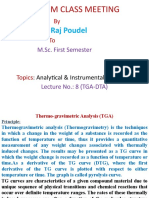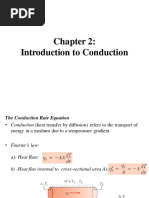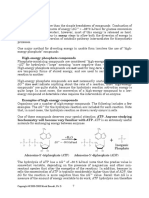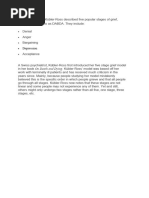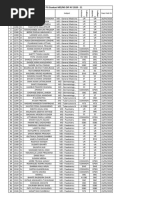The First Law of Thermodynamics: Closed Systems: Çengel Boles
The First Law of Thermodynamics: Closed Systems: Çengel Boles
Uploaded by
kebaman1986Copyright:
Available Formats
The First Law of Thermodynamics: Closed Systems: Çengel Boles
The First Law of Thermodynamics: Closed Systems: Çengel Boles
Uploaded by
kebaman1986Original Title
Copyright
Available Formats
Share this document
Did you find this document useful?
Is this content inappropriate?
Copyright:
Available Formats
The First Law of Thermodynamics: Closed Systems: Çengel Boles
The First Law of Thermodynamics: Closed Systems: Çengel Boles
Uploaded by
kebaman1986Copyright:
Available Formats
Çengel
Boles
CHAPTER
3
The First Law of
Thermodynamics
Thermodynamics:
Closed Systems
Third Edition
WCB/McGraw-Hill © The McGraw-Hill Companies, Inc.,1998
3-22
Chapter Summary
• The first law of thermodynamics is essentially
Çengel an expression of the conservation of energy
Boles
principle. Energy can cross the boundaries of
Thermodynamics
a closed system in the form of heat or work.
• If the energy transfer across the boundaries of
a closed system is due
to a temperature difference, it is heat;
otherwise, it is work.
Third Edition
WCB/McGraw-Hill © The McGraw-Hill Companies, Inc.,1998
3-23
Chapter Summary
• Heat is transferred in three ways: conduction,
convection, and radiation.
Çengel › Conduction is the transfer of energy from the more
Boles
energetic particles of a substance to the adjacent less
Thermodynamics
energetic ones as a result of interactions between the
particles.
› Convection is the mode of energy transfer between a
solid surface and the adjacent liquid or gas that is in
motion, and it involves the combined effects of
conduction and fluid motion.
› Radiation is the energy emitted by matter in the form of
electromagnetic waves (or photons) as a result of the
changes in the electronic configurations of the atoms
Third Edition
or molecules.
WCB/McGraw-Hill © The McGraw-Hill Companies, Inc.,1998
3-24
Chapter Summary
• The three modes of heat transfer are expressed
as:
Çengel
Boles
Thermodynamics
Third Edition
WCB/McGraw-Hill © The McGraw-Hill Companies, Inc.,1998
3-25
Chapter Summary
• Various forms of work are expressed as follows:
› Electrical work: (kJ)
Çengel
Boles
› Boundary work: (kJ)
Thermodynamics
› Gravitational work (=DPE): (kJ)
› Acceleration work (=DKE): (kJ)
› Shaft work: (kJ)
› Spring work: (kJ)
Third Edition
WCB/McGraw-Hill © The McGraw-Hill Companies, Inc.,1998
3-26
Chapter Summary
Çengel • For the ploytropic process (Pvn = constant) of real
Boles gases, the boundary work can be expressed as:
Thermodynamics
Third Edition
WCB/McGraw-Hill © The McGraw-Hill Companies, Inc.,1998
3-27
Chapter Summary
• The energy balance for any system undergoing
Çengel any process can be expressed as:
Boles
Thermodynamics
Third Edition
WCB/McGraw-Hill © The McGraw-Hill Companies, Inc.,1998
3-28
Chapter Summary
• The energy balances for any system undergoing
Çengel any process can be expressed in the rate form as:
Boles
Thermodynamics
Third Edition
WCB/McGraw-Hill © The McGraw-Hill Companies, Inc.,1998
3-29
Chapter Summary
• Taking heat transfer to the system and work done
by the system to be positive quantities, the energy
Çengel balance for a closed system can also be
Boles
expressed as:
Thermodynamics
where:
Third Edition
WCB/McGraw-Hill © The McGraw-Hill Companies, Inc.,1998
3-30
Chapter Summary
• For a constant-pressure process, .
Çengel
Boles Thus
Thermodynamics
Third Edition
WCB/McGraw-Hill © The McGraw-Hill Companies, Inc.,1998
3-31
Chapter Summary
• The amount of energy needed to raise the
Çengel temperature of a unit of mass of a substance by
Boles one degree is called the specific heat at constant
Thermodynamics
volume Cv for a constant-volume process and the
specific heat at constant pressure Cp for a
constant pressure process. They are defined as:
Third Edition
WCB/McGraw-Hill © The McGraw-Hill Companies, Inc.,1998
3-32
Chapter Summary
• For ideal gases u, h, Cv, and Cp are functions of
Çengel temperature alone. The u and h of ideal gases
Boles
can be expressed as:
Thermodynamics
Third Edition
WCB/McGraw-Hill © The McGraw-Hill Companies, Inc.,1998
3-33
Chapter Summary
• For ideal gases Cv, and Cp are related by:
Çengel
Boles
Thermodynamics
Third Edition
WCB/McGraw-Hill © The McGraw-Hill Companies, Inc.,1998
3-34
Chapter Summary
• The specific heat ratio k is defined as:
Çengel
Boles
Thermodynamics
Third Edition
WCB/McGraw-Hill © The McGraw-Hill Companies, Inc.,1998
3-35
Chapter Summary
• For incompressible substances (liquids and
Çengel solids), both the constant-pressure and constant-
Boles volume specific heats are identical and denoted
Thermodynamics
by C:
Third Edition
WCB/McGraw-Hill © The McGraw-Hill Companies, Inc.,1998
3-36
Chapter Summary
• The u and h of incompressible substances are
Çengel given by
Boles
Thermodynamics
Third Edition
WCB/McGraw-Hill © The McGraw-Hill Companies, Inc.,1998
3-37
Chapter Summary
Çengel
Boles
• The refrigeration and freezing of foods is a major
Thermodynamics
application area of thermodynamics.
Third Edition
WCB/McGraw-Hill © The McGraw-Hill Companies, Inc.,1998
3-1
Heat Transfer
(Fig. 3-3)
Çengel
Boles
Thermodynamics
Third Edition
WCB/McGraw-Hill © The McGraw-Hill Companies, Inc.,1998
3-2
Adiabatic Process
(Fig. 3-4)
Çengel
Boles
Thermodynamics
Third Edition
WCB/McGraw-Hill © The McGraw-Hill Companies, Inc.,1998
3-3
Convection: Heat Transfer
(Fig. 3-8)
Çengel
Boles
Thermodynamics
Third Edition
WCB/McGraw-Hill © The McGraw-Hill Companies, Inc.,1998
3-4
Convection: Cooling
(Fig. 3-9)
Çengel
Boles
Thermodynamics
Third Edition
WCB/McGraw-Hill © The McGraw-Hill Companies, Inc.,1998
3-5
Radiation
(Fig. 3-10)
Çengel
Boles
Thermodynamics
Third Edition
WCB/McGraw-Hill © The McGraw-Hill Companies, Inc.,1998
3-6
Heat and Work
(Fig. 3-15)
Çengel
Boles
Thermodynamics
Third Edition
WCB/McGraw-Hill © The McGraw-Hill Companies, Inc.,1998
3-7
Path Functions
(Fig. 3-16)
Çengel
Boles
Thermodynamics
Third Edition
WCB/McGraw-Hill © The McGraw-Hill Companies, Inc.,1998
3-8
Boundary Work
(Fig. 3-27)
Çengel
Boles
Thermodynamics
Third Edition
WCB/McGraw-Hill © The McGraw-Hill Companies, Inc.,1998
3-9
Net Work per Cycle
(Fig. 3-29)
Çengel
Boles
Thermodynamics
Third Edition
WCB/McGraw-Hill © The McGraw-Hill Companies, Inc.,1998
3-10
Schematic/Diagram for Ex. 3-8
(Fig. 3-31)
Çengel
Boles
Thermodynamics
Third Edition
WCB/McGraw-Hill © The McGraw-Hill Companies, Inc.,1998
3-11
Schematic/Diagram for Ex. 3-9
(Fig. 3-32)
Çengel
Boles
Thermodynamics
Third Edition
WCB/McGraw-Hill © The McGraw-Hill Companies, Inc.,1998
3-12
Schematic/Diagram for the
Polytropic Process
(Fig. 3-33)
Çengel
Boles
Thermodynamics
Third Edition
WCB/McGraw-Hill © The McGraw-Hill Companies, Inc.,1998
3-13
Schematic/Diagram for Ex. 3-13
(Fig. 3-43)
Çengel
Boles
Thermodynamics
Third Edition
WCB/McGraw-Hill © The McGraw-Hill Companies, Inc.,1998
3-14
Stretching a Liquid Film
(Fig. 3-45)
Çengel
Boles
Thermodynamics
Third Edition
WCB/McGraw-Hill © The McGraw-Hill Companies, Inc.,1998
3-15
System Energy Change
(Fig. 3-52)
Çengel
Boles
Thermodynamics
Third Edition
WCB/McGraw-Hill © The McGraw-Hill Companies, Inc.,1998
3-16
Energy Change for a Cycle
(Fig. 3-54)
Çengel
Boles
Thermodynamics
Third Edition
WCB/McGraw-Hill © The McGraw-Hill Companies, Inc.,1998
3-17
Closed-Systems, First-Law
(Fig. 3-55)
Çengel
Boles
Thermodynamics
Third Edition
WCB/McGraw-Hill © The McGraw-Hill Companies, Inc.,1998
3-18
Formal Definitions of Cv and Cp
(Fig. 3-72)
Çengel
Boles
Thermodynamics
Third Edition
WCB/McGraw-Hill © The McGraw-Hill Companies, Inc.,1998
3-19
Specific Heats for Some Gases
(Fig. 3-76)
Çengel
Boles
Thermodynamics
Third Edition
WCB/McGraw-Hill © The McGraw-Hill Companies, Inc.,1998
3-20
Three Ways to Calculate ²u
(Fig. 3-80)
Çengel
Boles
Thermodynamics
Third Edition
WCB/McGraw-Hill © The McGraw-Hill Companies, Inc.,1998
3-21
Typical Freezing Curve (food)
(Fig. 3-91)
Çengel
Boles
Thermodynamics
Third Edition
WCB/McGraw-Hill © The McGraw-Hill Companies, Inc.,1998
You might also like
- CH 3 ForecastingDocument20 pagesCH 3 Forecastingkebaman1986No ratings yet
- CHPT03Document38 pagesCHPT03milt80No ratings yet
- The First Law of Thermodynamics: Control Volumes: Çengel BolesDocument34 pagesThe First Law of Thermodynamics: Control Volumes: Çengel Boleskebaman1986No ratings yet
- CHPT 01Document32 pagesCHPT 01jhonNo ratings yet
- CHPT01 CengalDocument32 pagesCHPT01 CengalnsbaruaoleNo ratings yet
- Properties of Pure Substances: Çengel BolesDocument34 pagesProperties of Pure Substances: Çengel Boleskebaman1986No ratings yet
- Thermodynamic Property Relations: Çengel BolesDocument19 pagesThermodynamic Property Relations: Çengel Boleskebaman1986No ratings yet
- Properties of Pure Substances: Çengel BolesDocument33 pagesProperties of Pure Substances: Çengel BolesAbdelazim MohamedNo ratings yet
- The Second Law of Thermodynamics: Ç Engel BolesDocument33 pagesThe Second Law of Thermodynamics: Ç Engel Bolespgay340248No ratings yet
- Chemical and Phase Equilibrium: Çengel BolesDocument22 pagesChemical and Phase Equilibrium: Çengel Boleskebaman1986No ratings yet
- CHPT02Document33 pagesCHPT02milt80No ratings yet
- Refrigeration Cycles: Çengel BolesDocument24 pagesRefrigeration Cycles: Çengel Boleskebaman1986No ratings yet
- Refrigeration Cycles Chpt10 Çengel BolesDocument24 pagesRefrigeration Cycles Chpt10 Çengel BolesDocumentos De Interés para IngenieríaNo ratings yet
- Entropy: A Measure of Disorder: Çengel BolesDocument52 pagesEntropy: A Measure of Disorder: Çengel Bolesabhist singhNo ratings yet
- Lecture No.7 Thermodynamics-I by Engineer Noor RahmanDocument54 pagesLecture No.7 Thermodynamics-I by Engineer Noor RahmanHassan MalikNo ratings yet
- Entropy: A Measure of Disorder: Çengel BolesDocument52 pagesEntropy: A Measure of Disorder: Çengel Boleskebaman1986No ratings yet
- Exergy: A Measure of Work Potential: Çengel BolesDocument30 pagesExergy: A Measure of Work Potential: Çengel Boleskebaman1986No ratings yet
- Siklus Rankine Pltu Dan Pembangkit Hibrida Pltgu: Çengel BolesDocument20 pagesSiklus Rankine Pltu Dan Pembangkit Hibrida Pltgu: Çengel BolesSatriyo PamungkasNo ratings yet
- Sesi - 3-PEL-Siklus Rankine Dan Latihan AplikasiDocument36 pagesSesi - 3-PEL-Siklus Rankine Dan Latihan AplikasiReza FathurrahmanNo ratings yet
- Gas Mixtures: Çengel BolesDocument18 pagesGas Mixtures: Çengel Boleskebaman1986No ratings yet
- Chemical Reactions: Çengel BolesDocument40 pagesChemical Reactions: Çengel Boleskebaman1986No ratings yet
- The Second Law of Thermodynamics: Çengel BolesDocument36 pagesThe Second Law of Thermodynamics: Çengel Boleskebaman1986No ratings yet
- Gas-Vapor Mixtures and Air-Conditioning: Çengel BolesDocument37 pagesGas-Vapor Mixtures and Air-Conditioning: Çengel Boleskebaman1986No ratings yet
- Chpt14 Chemical Reaction (Combustion) Cengel & BolesDocument40 pagesChpt14 Chemical Reaction (Combustion) Cengel & BolesDocumentos De Interés para IngenieríaNo ratings yet
- CHPT08Document53 pagesCHPT08Crissa Ann EqueNo ratings yet
- MSC I Sem - BRP - Lect 8Document20 pagesMSC I Sem - BRP - Lect 8Nutan GautamNo ratings yet
- 3 ThermodynamicDocument162 pages3 ThermodynamicRenaldy PrasdiansyahNo ratings yet
- Chapter 2Document14 pagesChapter 2wsv6xpqphfNo ratings yet
- Chapter 2Document14 pagesChapter 2wsv6xpqphfNo ratings yet
- Engine Simulation PetrolDocument116 pagesEngine Simulation PetrolChinmay DamleNo ratings yet
- ENGG111 Thermodynamics Lecture 2Document27 pagesENGG111 Thermodynamics Lecture 2Arima KouseiNo ratings yet
- Heat & ThermodynamicsDocument25 pagesHeat & ThermodynamicsAtik ShariarNo ratings yet
- CHPT04Document39 pagesCHPT04milt80No ratings yet
- Vapor and Combined Power Cycles: Çengel BolesDocument20 pagesVapor and Combined Power Cycles: Çengel BolesSalman ShaxShax HeissNo ratings yet
- Sirine 3Document10 pagesSirine 3Syrine BOUDEFNo ratings yet
- 2019 Chen Stoehr CF Author FinalDocument32 pages2019 Chen Stoehr CF Author FinalsoroushNo ratings yet
- Properties of Gases: Chapter OutlineDocument40 pagesProperties of Gases: Chapter OutlineDeep PatelNo ratings yet
- Simmulated AnnealingDocument3 pagesSimmulated AnnealingBrian SanchezNo ratings yet
- Thermo Dynamics 4Document1 pageThermo Dynamics 4brochill1344No ratings yet
- Groulx PaperDocument8 pagesGroulx PaperSafdar AbbasNo ratings yet
- Refrigeration Cycles: Çengel BolesDocument24 pagesRefrigeration Cycles: Çengel BolesMuhammad QayyumNo ratings yet
- Advanced 3D Modelling For Anode Baking FurnaceDocument6 pagesAdvanced 3D Modelling For Anode Baking Furnacefariza_yunitaNo ratings yet
- EGB323 Week 3 Lecture ENG 2019Document59 pagesEGB323 Week 3 Lecture ENG 2019polfzxkwwavcrlnllzNo ratings yet
- What Is The Joule-Thomson Effect?Document10 pagesWhat Is The Joule-Thomson Effect?Vivi OktaviantiNo ratings yet
- HT Assignment 1-5 Odd 2023-24Document5 pagesHT Assignment 1-5 Odd 2023-24Prajapati DhavalNo ratings yet
- Kilic Clutch 2016Document7 pagesKilic Clutch 2016marcglebNo ratings yet
- Artigo ApresentarDocument10 pagesArtigo ApresentarjglfernandesNo ratings yet
- Entropy, Free Energy and EquilibriumDocument57 pagesEntropy, Free Energy and EquilibriumSilver RitzNo ratings yet
- Numerical Simulation of Electrical Spark Ignition in A Methane-Air MixtureDocument12 pagesNumerical Simulation of Electrical Spark Ignition in A Methane-Air MixtureAghajaniNo ratings yet
- 儀分 Ch31 ThermalDocument57 pages儀分 Ch31 ThermalSaurabh ShashankNo ratings yet
- Javed AssignmentDocument26 pagesJaved AssignmentMustafaNo ratings yet
- Chapter 12A:: Basic Thermodynamics and LawsDocument25 pagesChapter 12A:: Basic Thermodynamics and LawsAnonymous mRBbdopMKfNo ratings yet
- Steady State Modeling of A Fire Tube BoilerDocument5 pagesSteady State Modeling of A Fire Tube BoilerBenjamin Angel Flores ZavalaNo ratings yet
- Physics Chapter-13-Ppt - MergedDocument70 pagesPhysics Chapter-13-Ppt - MergedtumalomprincessveaNo ratings yet
- Primary Reformers - Theory and OperationDocument34 pagesPrimary Reformers - Theory and OperationMuhammad Wahaj Butt100% (2)
- Exp 3 - TgaDocument7 pagesExp 3 - TgailknurNo ratings yet
- CHAPTER 3 Concepts of ThermodynamicsDocument36 pagesCHAPTER 3 Concepts of Thermodynamicsfaitholiks841No ratings yet
- Notes For Advanced Learning MathsDocument13 pagesNotes For Advanced Learning MathsAman TewariNo ratings yet
- A Fundamental Approach To Transformer Thermal Part IDocument5 pagesA Fundamental Approach To Transformer Thermal Part IAlberto OrtizNo ratings yet
- Carbon Dioxide Thermodynamic Properties Handbook: Covering Temperatures from -20° to 250°C and Pressures up to 1000 BarFrom EverandCarbon Dioxide Thermodynamic Properties Handbook: Covering Temperatures from -20° to 250°C and Pressures up to 1000 BarNo ratings yet
- Chemical Reactions: Çengel BolesDocument40 pagesChemical Reactions: Çengel Boleskebaman1986No ratings yet
- Thermodynamic Property Relations: Çengel BolesDocument19 pagesThermodynamic Property Relations: Çengel Boleskebaman1986No ratings yet
- Chemical and Phase Equilibrium: Çengel BolesDocument22 pagesChemical and Phase Equilibrium: Çengel Boleskebaman1986No ratings yet
- The Second Law of Thermodynamics: Çengel BolesDocument36 pagesThe Second Law of Thermodynamics: Çengel Boleskebaman1986No ratings yet
- Gas Mixtures: Çengel BolesDocument18 pagesGas Mixtures: Çengel Boleskebaman1986No ratings yet
- Gas-Vapor Mixtures and Air-Conditioning: Çengel BolesDocument37 pagesGas-Vapor Mixtures and Air-Conditioning: Çengel Boleskebaman1986No ratings yet
- Refrigeration Cycles: Çengel BolesDocument24 pagesRefrigeration Cycles: Çengel Boleskebaman1986No ratings yet
- Entropy: A Measure of Disorder: Çengel BolesDocument52 pagesEntropy: A Measure of Disorder: Çengel Boleskebaman1986No ratings yet
- Project ManagementDocument44 pagesProject Managementkebaman1986No ratings yet
- Lubrication SystemDocument43 pagesLubrication Systemkebaman1986100% (1)
- Project ManagementDocument40 pagesProject Managementkebaman1986No ratings yet
- CH 2 Plant LayoutDocument28 pagesCH 2 Plant Layoutkebaman1986100% (1)
- Exergy: A Measure of Work Potential: Çengel BolesDocument30 pagesExergy: A Measure of Work Potential: Çengel Boleskebaman1986No ratings yet
- Basic Accounting Principles and Budgeting FundamentalsDocument24 pagesBasic Accounting Principles and Budgeting Fundamentalskebaman1986100% (1)
- TwoPhaseFlow PDFDocument13 pagesTwoPhaseFlow PDFkebaman1986No ratings yet
- Workshop Tech 2Document7 pagesWorkshop Tech 2kebaman1986No ratings yet
- General Machine Shop SafetyDocument6 pagesGeneral Machine Shop Safetykebaman1986No ratings yet
- Chapter One: The Concept of Entrepreneurship and EntrepreneurDocument32 pagesChapter One: The Concept of Entrepreneurship and Entrepreneurkebaman1986No ratings yet
- Modicon M580: Hardware Reference ManualDocument398 pagesModicon M580: Hardware Reference ManualJoão Paulo Falci BarbosaNo ratings yet
- The Perception of Prevalence of Aggression Scale (POPAS) QuestionnaireDocument10 pagesThe Perception of Prevalence of Aggression Scale (POPAS) QuestionnaireCristina TrifulescuNo ratings yet
- Executive Summary Business ConceptDocument3 pagesExecutive Summary Business ConceptTemogo RaphutiNo ratings yet
- MROT ReviewerDocument15 pagesMROT Reviewerjpleyson0919No ratings yet
- Well Tests Diagnostic PlotsDocument6 pagesWell Tests Diagnostic PlotsManuel LealNo ratings yet
- RabiesDocument10 pagesRabiesWinda LiraNo ratings yet
- Labour Law Ii RPDocument12 pagesLabour Law Ii RPgavileNo ratings yet
- Grounding and Sinking of Commercial Fishing Vessel Pacific QueenDocument5 pagesGrounding and Sinking of Commercial Fishing Vessel Pacific QueenNational Transportation Safety BoardNo ratings yet
- Customer Perception of KFC in BhilaiDocument5 pagesCustomer Perception of KFC in Bhilaipooja raiNo ratings yet
- Teamwork A Concept AnalysisDocument10 pagesTeamwork A Concept AnalysisLidwina KusumaNo ratings yet
- EMC - Kerala Distribution Transformer Loss Study - 175-208Document34 pagesEMC - Kerala Distribution Transformer Loss Study - 175-208Santanu MandalNo ratings yet
- Embryo Trans PDFDocument4 pagesEmbryo Trans PDFDavid FelmeriNo ratings yet
- Jsa Worksheet Appendix 1: A-2401 Cooling Tower Pond CleaningDocument4 pagesJsa Worksheet Appendix 1: A-2401 Cooling Tower Pond CleaningAmmadRehmanNo ratings yet
- 18196Document4 pages18196RianNo ratings yet
- Asphalt Core Test-1Document2 pagesAsphalt Core Test-1Chandra Prakash KarkiNo ratings yet
- Project TitleDocument3 pagesProject TitlemaniNo ratings yet
- 1-OS&Y REL-OSY-L399F R0049C - ReliableDocument2 pages1-OS&Y REL-OSY-L399F R0049C - ReliableMohamed FayezNo ratings yet
- STP WP BrochureDocument8 pagesSTP WP BrochureRana MahatoNo ratings yet
- Bio EnergeticsDocument8 pagesBio EnergeticsSamuel RookieNo ratings yet
- Medication Errors 2011Document29 pagesMedication Errors 2011Ummi Hani MaruanNo ratings yet
- HospitalDocument2 pagesHospitalUMHT BIO-MedicalNo ratings yet
- Death and Dying - Kubler Ross Stages of DyingDocument5 pagesDeath and Dying - Kubler Ross Stages of DyingReshmi DuttaNo ratings yet
- Can You Catch a Cold Untold History Human ExperimentsDocument571 pagesCan You Catch a Cold Untold History Human Experimentslbi05122008No ratings yet
- Tổng hợp các idioms thường gặp trong đề thi THPT Quốc GiaDocument9 pagesTổng hợp các idioms thường gặp trong đề thi THPT Quốc GiaTrần Tuấn LâmNo ratings yet
- Section 1:: Daily DairyDocument2 pagesSection 1:: Daily DairybalaNo ratings yet
- Sustainable Finance PolicyDocument54 pagesSustainable Finance PolicyHasain AhmedNo ratings yet
- Curriculum Vitae Dr. Hervina, SP - KK FINSDVDocument2 pagesCurriculum Vitae Dr. Hervina, SP - KK FINSDVArys SetiawanNo ratings yet
- Prime Meat Price ListDocument7 pagesPrime Meat Price ListSytherNo ratings yet
- 16 Del Pilar Academy Vs Del Pilar Academy Employees UnionDocument2 pages16 Del Pilar Academy Vs Del Pilar Academy Employees UnionMichael Gargantiel Carneo100% (1)
- Admission 2020 21 PG 1 4 MDMSDocument4 pagesAdmission 2020 21 PG 1 4 MDMSMR. TachyonNo ratings yet

